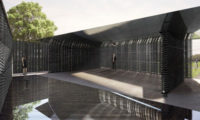The law school’s current facility, built in the 1980s when the student body was less than two-thirds its current size, hasn’t aged well. Cinderblock construction, inadequate lighting and HVAC systems, and an outmoded library are among the chief concerns in the old building; this last issue is especially problematic. The new multi-story library will be much more open, accommodating what Bogomolny describes as a marked increase in group-study and computer use.
While all parties involved stress that it’s too early to know many specifics about the project, it’s safe to assume that it will incorporate Stefan Behnisch’s famed attention to light and environmental sustainability. Though he’s based in Stuttgart, Behnisch himself was one of the center’s design leads, and he has promised to be heavily involved throughout the construction process.
Behnisch partner Matt Noblett says the firm intends to organize the school around a central atrium that uses the stack effect to exhaust air through the building, thereby minimizing the need for mechanical power. Other proposed features include a green roof and the extensive use of static and dynamic shading devices like louvers on the façade, and blinds sandwiched between two layers of glass.
Sited across the street from a train station at the crux of two major north-south streets, the new building will be a highly visible addition to its neighborhood. That’s fine by Bogomolny, who hopes the center will be an integral part of the revitalization of the city of Baltimore. He notes that the 400-seat moot court will benefit not only students, but also community residents who attend conferences. According to Mr. Bogomolny, “The health of the city impacts that of the university, and vice versa.”
The project is scheduled for completion in 2012.









Post a comment to this article
Report Abusive Comment